Is Cryptocurrency Sustainable?
Key Points:
- Bitcoin uses more energy per year than the whole country of Norway!
- At it’s highest in November 2021, Bitcoin was worth $1.7 Trillion which was around 35% of the total crypto market.
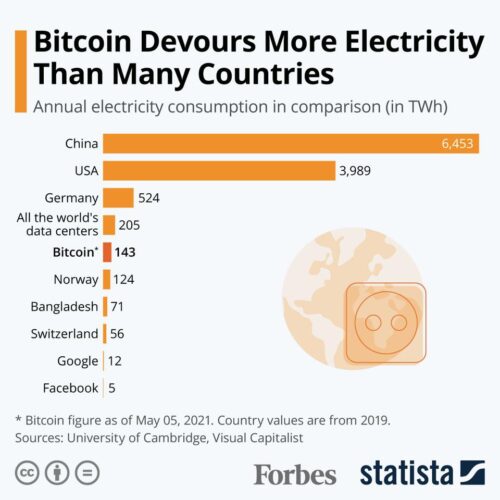


Back Story:
About a year ago crypocurreny seemed fake to me. It felt like moving digital numbers around and then making up their value. It felt like a concept more than a solid thing. However in the the same breath people talking about it were calling it the future of finance and investing real amounts money.
Over the the past few months I have been playing with a few digital coins and watching the market go up and down, listening to the language and trying to understand the whole concept. Most of all since I believe we need to become a more sustainable society for the good of future generations, I wanted to know… Is Crypto Sustainable?
In this article we will dissect a few important items about crypto:
- Is it even worth talking about from a money standpoint?
- How much energy is being used and why? How does that compare?
- Are there eco-friendly cryptocurrencies?
- Second Part: Why I chose one over all the others and have actually invested.
- Second Part: Major questions I still have.
Let’s get started!
–
#1 Is Crypto even worth talking about from a money standpoint?
Here are some Global Money Stats to consider:
Value of all Cryptocurrency in the Market:
- November 2021 = $3 Trillion
- March 2022 = $1.7 Trillion – The market can fluctuate a lot but has trended upward over time.
- Bitcoin and Ethereum is around 60% of the total market
Global Equity Trading Worldwide in 2022 = $37 Trillion
Trillions of dollars is no small sum of money and it’s higher than the GDP of many countries, but in terms of taking over the financial system, not so much. It is however having a real impacts and large investment firms are using it in their portfolios, countries are using it as legal tender and large corporations are taking it as payment.
As the digital world gets bigger and bigger with virtual reality, metaverse, NFTs and video games, using digital currency is on the rise and in my opinion worth thinking about.
#2. How much energy is being used and why? How does that compare?
The 2 largest coins Bitcoin and Ethereum make up about 60% of the market. Both of them use a mining method that is very energy intensive. This method is called proof of work and essentially uses computing power to mine coins and record transitions on a ledger aka the blockchain.
Below are the energy usages, in TWh, of the some of top cryptocurrencies. Remember the first 2 are Bitcoin and Ethereum which are 60% of the market. They also use the most energy being proof of work where the others could be using proof of stake which is a lot less energy intensive.
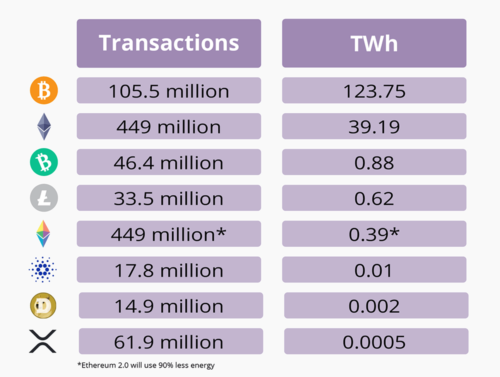


www.moneysupermarket.com/gas-and-electricity/features/crypto-energy-consumption/
That is a lot of energy for #1 and #2!
If the value increases for Bitcoin, more people will mine it, which will mean more competition and an increase in energy used to mine the coin.
Hard to predict where the price will go, but here is a chart showing increase of energy usage for Bitcoin over the past 10 years.
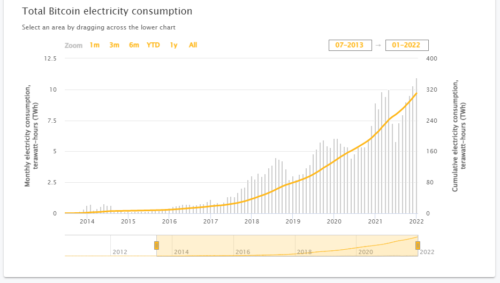


www.ccaf.io/cbeci/index
If you combine both the energy usage for Bitcoin and Ethereum it is more energy consumption than the country of Mexico!
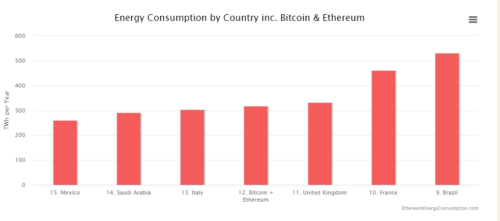


There has been predictions that Bitcoin alone could reach over 500 TWh per year which is more than France and possibly Brazil. Just for Bitcoin. However that is an estimate on the high side of the spectrum and would depend on few factors, value of bitcoin being the biggest.
Side note: It has been said that Bitcoin mining produces as much e-waste as the Netherlands. Which would be about 24 kilotons of e-waste each year as the average machine used for mining has a lifespan of about 18 months and are hard to re-purpose. They mention it feels like Bitcoin is like a old truck belching fumes, where there are new, better versions ready to be used.
On flip side, we need to consider, how much energy does our current monetary system use?
Below is a chart that in my opinion is tough comparison to make between energy used for tradition banking and gold with Crypto but they tried. Also Bitcoin plus Ethereum is the better comparison and that would bring it over 300TWh/yr. Plus the fact that Crypto is not widely accepted as legal tender even though there are work arounds with apps that convert Bitcoin to cash during a transactions at the cash register.
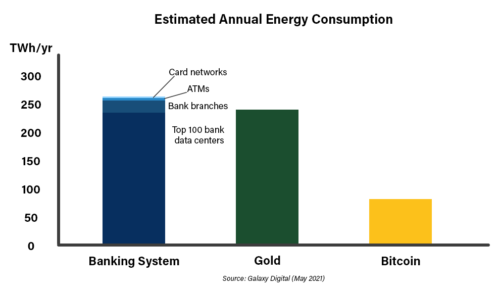


#3. Are there eco-friendly cryptocurrencies?
FYI: Googling “eco-friendly cryptocurrencies” is a trap!
The results will most likely bring you to links where they say a cryptocurrency is “eco” because it takes less energy to mine and create transactions. As you can see this is an important concept as the Crypto community needs to consider and develop better options than the energy intensive “proof of work” concepts of Bitcoin and Ethereum.
Just looking at their energy usage I would not necessarily call Bitcoin and Ethereum eco-friendly, although they possibly use the same amount of energy as our current monetary system, but lack some the functions that a traditional bank would provide.
I know some people are sitting here reading this and going, but Crypto has benefits that have not even mentioned and through those benefits comes a change in the systems that got us in this ecological mess to begin with.
That may be true, and if we are even going to be able to upack that statement we will first have to understand what crypocurrency actually is and how it actually functions and I will leave that to your personal exploration and interpretation. Here is a starter link called “What is Cryptocurrency“. Please know I or SEG are not endorsing this information and that Coinbase is a crypto trading website so their view will be on the pro-crypto side.
As I promised, I’ll leave you with my top pick for an Eco-Friendly Cryptocurrency, and it goes by the name of PowerLedger (POWR) which I will be discussing in Part 2 of this series.
Thank you for sticking with me on some dense, possibly new ground breaking information. Check in with SEG next month (sign up for our free newsletter at the bottom of this page) as we dive into PowerLedger and how it’s blockchain technology is enabling a part of India to share electricity from home to home while recording the transaction.
“The future is here, how can we make it more sustainable.” – Our SEG mantra!





